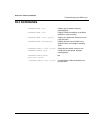
Doc Part Number, Version Number
9-
1
Chapter 9
Troubleshooting at the MAC Layer
Ethernet
Ethernet is a LAN based technology with data transmission rates of 10 or 100
Mbps. CSMA/CD (Carrier Sense Multiple Access with Collision Detection)
protocol dictates how Ethernet frames traverse the network. In CSMA/CD, an
Ethernet station checks for the presence of a signal on the cable. If there is no
signal, the station begins transmission. However, more than one station can sense
an idle channel and simultaneously begin to transmit data resulting in a collision.
When this occurs, all stations involved detect the collision and immediately stop
transmitting. After waiting a random time interval and ensuring that the line is
free, each station will retransmit. If another collision occurs, the station must wait
another random time interval before attempting to retransmit. After 16 tries, the
station reports that the network is unavailable and discards the frame.
Based on the CSMA/CD methodology, collisions are inherent to Ethernet and
considered ‘normal’. Retransmit delays due to collisions usually go unnoticed by
the users, however, on larger networks with hundreds of users, excessive
collisions may cause slow response times. Segmenting the network into smaller
collision domains should significantly improve network performance.


















